Content is king, BUT… Only when you create quality content.
And Creating quality content is not easy.
It’s become more difficult when you have to create content for your startup consistently.
And, you just can’t be inconsistent at producing content.
The problem and pain of many startups and business founder is simple.
They do want to create lots of valuable content consistently over a long period. But the process makes it hard.
There are lots of benefits if you learn to repurpose every piece of content effectively.
Content repurposing is the process of reusing existing pieces of content in a different format for purposes as well.
Benefits of content repurposing
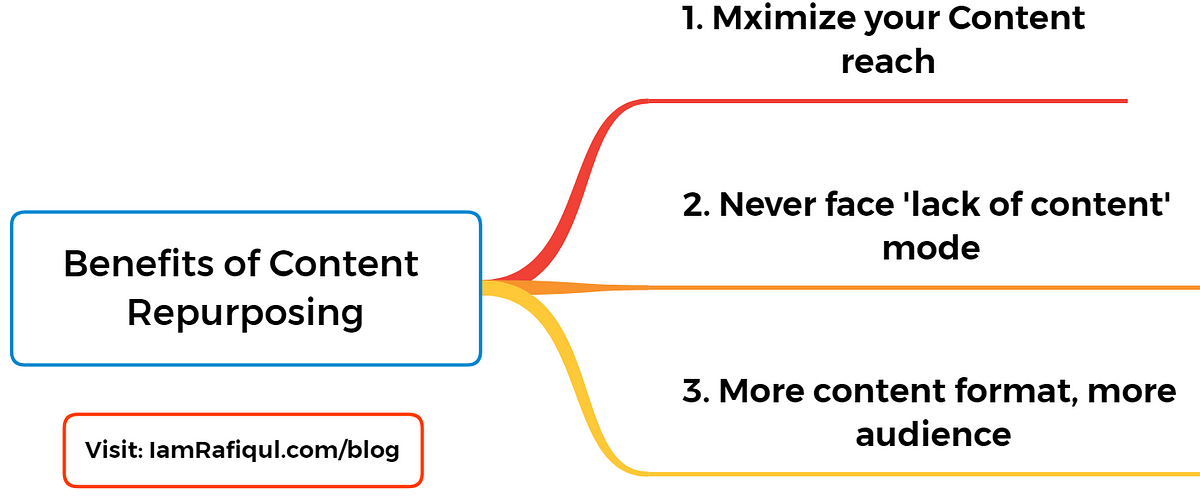
- First and foremost, this will help to maximize your content reach. The more content platform you choose, the more reach you’ll get. It just exponentially expands your reach.
- Consistency and long-term plan are must-have components in your content marketing plan. Because of repurposing, you’ll have more numbers of content to publish. That way, you can schedule all of your posts for a long time while maintaining consistency.
- You will be able to reach a more targeted audience because not everyone likes text-based content or video format. But when you repurpose one piece of content into different content formats, you’ll eventually have more audience by your side.
A Bonus Benefit of Content Repurposing
You can leverage multiple content formats at one time. On one of your blogs, you can embed YouTube videos, Slideshare’s presentation, Infographics, or even podcasts.
What’s the actual benefit?
That will help you to boost your other content channels from one place. Let’s say someone visited your blog. From there, the person notices your other channels like YouTube, podcasts.
Now, two things could happen. First, they will just ignore other channels from your blog post and focus on a particular content format.
Second, your visitor could even go to your other channels to learn more about the content you offer.
So, why would you want to waste even 1% of the potential of your content?
That way, you will also be able to bring traffic from one channel to another by integrating multiple content formats in your content.
That is why you must understand and implement content repurposing with a rock-solid strategy.
Okay, let me just give you a quick overview of what’s inside of this article.
Things you’ll learn from this section:
- How to get 24 weeks of content ready in just four weeks?
- Which blog posts need to be repurposed?
- Strategy to repurpose your old blog posts
Let’s dive into each of this one-by-one.
1. How to get 24 weeks of content ready in just four weeks?

Content repurposing is about using your existing content in a different format to increase your content reach. By changing the format of the original content, you can use it for different purposes for the same or different customer stages.
Let me cite an example.
Let’s say you’ve created a blog post on “6 advantages of using the solar panel”.
Assume the content is made for the awareness stage. Now, you can create an infographic listing all of these 6 advantages. Also, you can use these 6 points and create six different Facebook posts.
That way, you’re using one piece of content (In this case, a blog post) in multiple ways.
That is how content repurposing works at a basic level.
Whenever you’re creating content for the startup, you must make sure that every piece of content that you create can be repurposed in different formats.
Suggested article for you: How to leverage blogging for business
You may have now understood how to turn your blog post into a different content format.
But content repurposing is more about content strategy and less about creating the different formats from a single piece of content.
The content repurposing approach that I have used many times in my job can be started in two ways.
- Large to Short Approach: Start with a long-form of content and then break it into small pieces of content for different content platforms. Or,
- Small to Large Approach: Start with creating short-form of content and then turn it into a long-form.
Both way, you can manage your content strategy effectively.
Now, let’s understand how to perform this strategically, even if you’re just starting your content marketing campaign from scratch.
As I have discussed the role of considering buyer stage for creating content, you need to plan for each of the buyers’ stage.
Now you’re ready to create content according to the buyer stage.
Let’s start with the following content creation process considering each stage of the buyer.
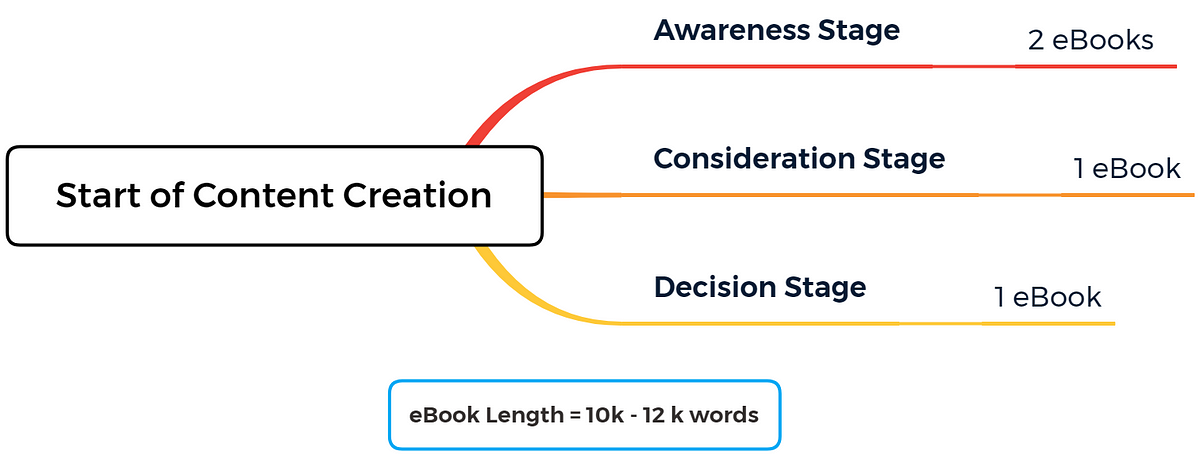
Since the awareness stage is crucial for attracting your target audience, I’ve considered more content than the other two stages.
Also, consider that each eBook’s length is around 12,000 words.
Let’s see how we can use each of these eBooks effectively.
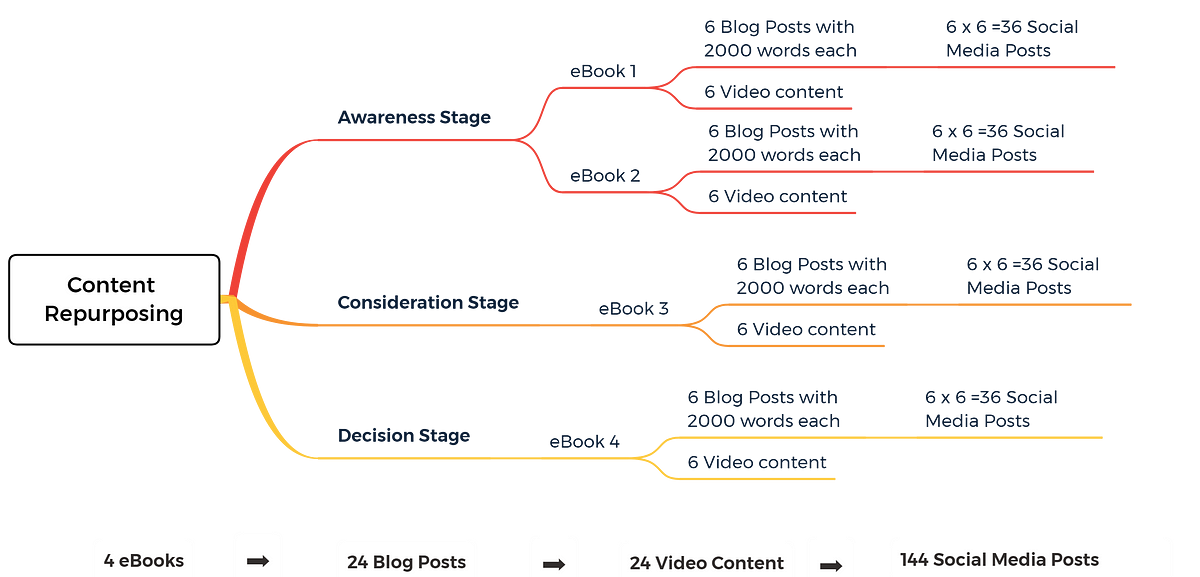
Here’s what the above illustration shows.
- An eBook of 12,000 words is long enough for re-creating six blog posts with 2,000 words each. (If your eBook consists of 6 chapters, then you can turn each of these chapters into a blog post.)
- Now, you can use the topic of each blog post to turn it into a video format.
- Likewise, images used in each of these blog posts can then used as social media content. (Infographics and images work well in this case)
Guess how much time is needed to create content for almost 24 weeks?
Only four weeks.
Here’s the breakdown.
| Content Format | Time to create |
| 4 eBooks (with 12,000 words each) | 2 weeks |
| 24 Blog Posts (re-formatting) | 1 week |
| 24 video content (using the content of each blog post) | 1 week |
| 144 social media posts | 1-2 days |
| *Considering 7 hours/day and 5 days/week |
Spending almost 4 weeks will give you content for almost 24 weeks.
Isn’t it so amazing?
HubSpot is one of the companies that use this technique effectively. If you observe the content, you can see that they get the most out of a piece of content.
One of the most popular courses on content marketing, offered by HubSpot Academy, also follows this process.
Over the years, they have created many useful and valuable content on the topic of content marketing. What they have done is simply organizing the content in a way that it covers most of the aspect of content marketing.
That way, they have managed to create a complete course on content marketing without creating the content from scratch.
So, what do you need to consider if you, too, want to utilize your content in the best way?
Steps to get most out of your content
The first step is to create an outline in which you’ll analyze a few topics (targeted for any of the buyer stages)for long-form content.
Whether you start creating long-form content or short-form, you must have a clear idea about the repurposing.
Here’s an example.
The next step is to structure the eBook in different subtopics. An eBook could have multiple subtopics. And, you need to consider each of these sub-topics as blog posts.
Even if you’re investing time and energy in writing an eBook, you’re also creating the outline and content for your upcoming blog posts.
Don’t just write an eBook without having a goal of creating repurposing it in the form of a blog post.
Before you start typing a single word for your eBook, you must create an outline for the subtopics. Because each of these subtopics from the eBook can be then used as a blog post.
Likewise, if you want to start with a blog post instead of an eBook(long-form of content), you can follow the same. Start with the subtopics.
Once you complete writing all of the subtopics in the form of a blog post, you can later combine it to make an eBook.
Think of this as a puzzle. You start with small pieces and later put it together or start with a complete puzzled and later cut it into different shapes and sizes.
The complete puzzle is long-form content, whereas the small pieces denote blog posts (or any other short form of content).
Here’s how does it look like.
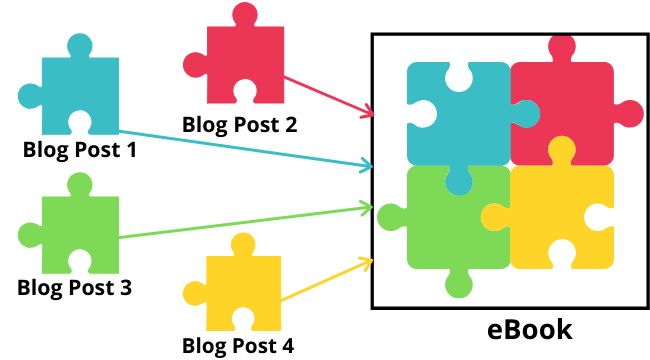
Start with blog posts (short-form) and later turn it into a long-form content like eBook.
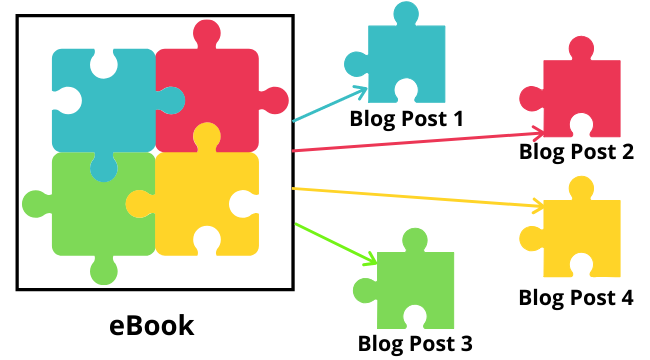
Handpicked article for you: How to select the right content format for your business
Likewise, you can turn your eBook into many small-form of content as well.
This approach can also be applied in video content as well. You can also repurpose your blog posts into video content as well.
The key is to set an end goal and work accordingly. Don’t just create a single piece of content that doesn’t belong to your end goal.
Even if you have to create, make sure you will repurpose it as many ways as possible.
Here, I am giving some smart tips that you can apply to maximize your outcome in repurposing.
Blog post to Video
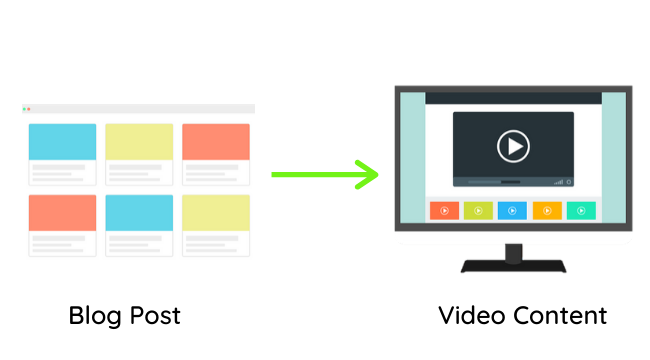
Making valuable video content is truly not an easy task, but when you already have content ready for your video creation, then your job becomes much easier. You can use your blog content as a transcription of your video. So many organizations are also doing in this way
First, you need to choose the topic.
Second, edit your blog article for the video format. For example, you may have written phrases like, “In this article, you’ll learn…” You don’t want that portion in your video.
Third, add more visuals so that your audience can consume it with ease.
Yay! Your video is ready, and you haven’t worked for so long to make it as well.
Relevant Read: Learn how to build a video first content marketing strategy
Video Presentation/ webinar to social Media Post
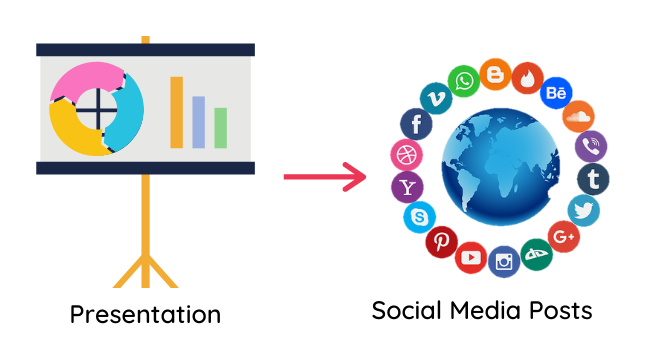
A video presentation or webinar is one of the most common types of content that easily engages your viewers. So, next time you plan a presentation, consider the below points.
Use more cool looking graphs, charts, and animated slides in your presentation.
Each of these slides or charts is ready to go live on social media. You can easily collect more than five social media posts from a single webinar or presentation on average.
The more charts and illustrations you use, the more social media posts are ready.
Mind Map as a Lead Magnet
Using a Mind Map is also a great way to make it super easy for anyone to understand any concept.
Once you have many presentations made with Mind Map, combine all of the pdf files of Mind Map and present it as a downloadable resource.
You can either use it as a lead magnet or send it to your email subscribers. Both way, you’re creating value for your audience without creating new.
[You’ll see lots of Mind Map in my blog as well]
List Post to Social Media Posts
This is one of my favorite way of increasing the content reach.
Recently I have published a blog post on “17 tips on creating high-quality content”.
I just simply divided the whole article into 17 pieces of a short form of content for using it on social media.
This is why I have added almost 15 images on the blog post. First, this will help me in creating a more visually appealing article. Second, I can repurpose these images as well.
One single article gave me 17 awesome short-form of content.
List-post works great. All you need to do is break your whole article into small pieces.
This is another reason why you should add multiple images, customer graphics, illustration as well.
[Pro Tip: Whenever you create content, have a plan of reusing it in the future. Every piece of content must be created in a way that you can repurpose it later.]
Let’s move forward to another approach to repurposing.
2. Which blog posts need to be repurposed?
Identifying which blog post deserves your effort and energy to be repurposed is necessary.
When it comes to updating and reusing your old content, you just cannot take any random old article and start publishing again after adding some value in it.
The rule is not every piece of a blog post that you have created in the past needs to be repurposed.
So, the obvious question is how to know which content to choose and which content to avoid?
This is what I look for when selecting the right blog article to repurpose.
(*I have used these tactics for a few of my clients and found some impressive results)
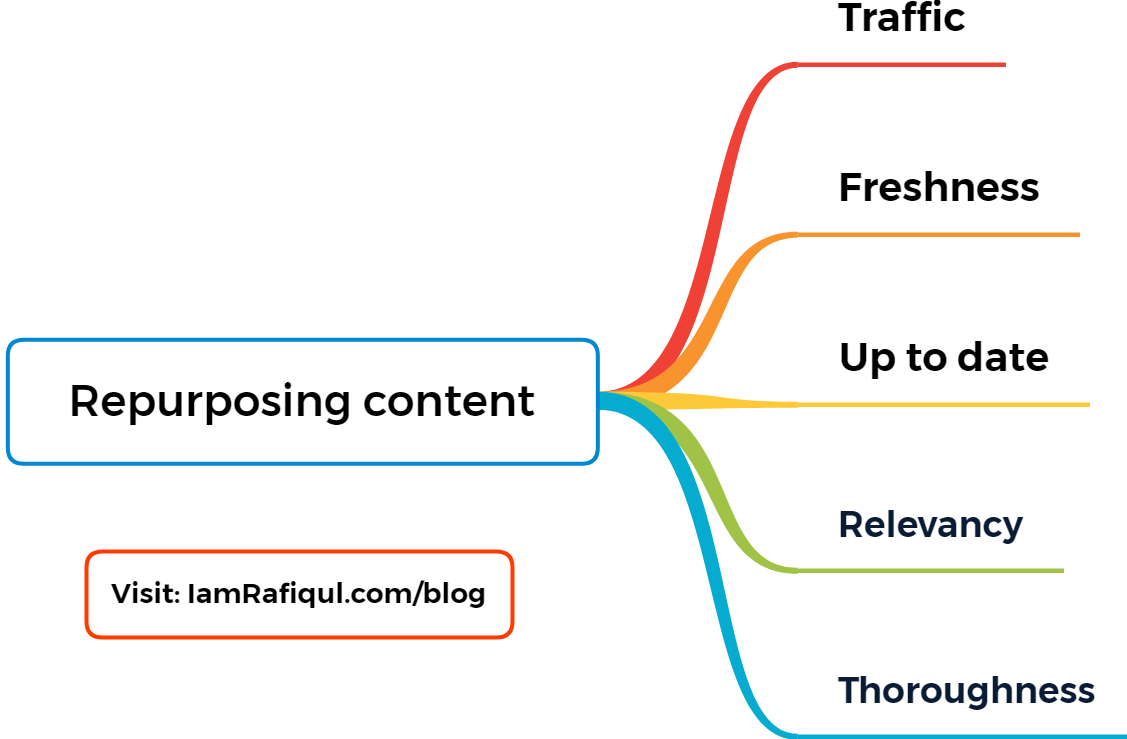
- Traffic
- Freshness
- Up to date
- Relevancy
- Thoroughness
Let’s understand how you can implement this for your content plan.
Traffic
First, I look for the monthly traffic that the site gets. Paid traffic is not included in the traffic volume. You can either use premium tools or look at the google search console to know which blog post works best in terms of monthly traffic.
Now, don’t just restrict your research on google search traffic. Traffic from any of the sources such as Quora, YouTube, and others could be a KPI in this case.
Now, once I list down the number of blog posts that get a good amount of traffic, I will start seeing each blog post’s age.
Remember only repurpose content that is at least one year old (even less if it is not updated with the latest content).
That way, you, can find a list of articles that gets traffic and published at least a year ago.
Now, I follow the next KPI, which is freshness.
Freshness and up-to-date
Just ask yourself one simple question.
Is this content still fresh as compared to the recent updates?
Find blog posts that are not fresh in the current time. Let’s say an article on “best SEO tips for beginners,” published two years ago.
This is not an evergreen topic because every year, Google brings core updates to its algorithm.
Therefore the content on SEO tips needs to be updated with fresh updates and news as well.
Relevancy
It is possible that the number of services in your company may increase or decrease.
So if you find content that is no longer relevant to your service or product, then you might choose it to re-create with the details of service or product that is currently relevant to you.
Thoroughness
This is a must-have factor. Even Google officially stated that in-depth article is what they’re looking for.
You just cannot write a 500 words article and starting ranking on multiple keywords. This might be the case in 2010, but not in 2020 and the upcoming years as well.
Try to create content specific topics and cover queries as much as possible (if not every query people ask) regarding your topic. This will help you to create an in-depth article.
So, what you can do is look for the outdated content and check whether it is a comprehensive guide.
If not, then consider this to your list.
This KPI brings me to the last part of this article: how to repurpose your blog post?
3. Strategy to repurpose your old blog posts
Here comes the most important part.
Once you identify the blog posts that need a fresh look, you can implement this strategy into your blog.
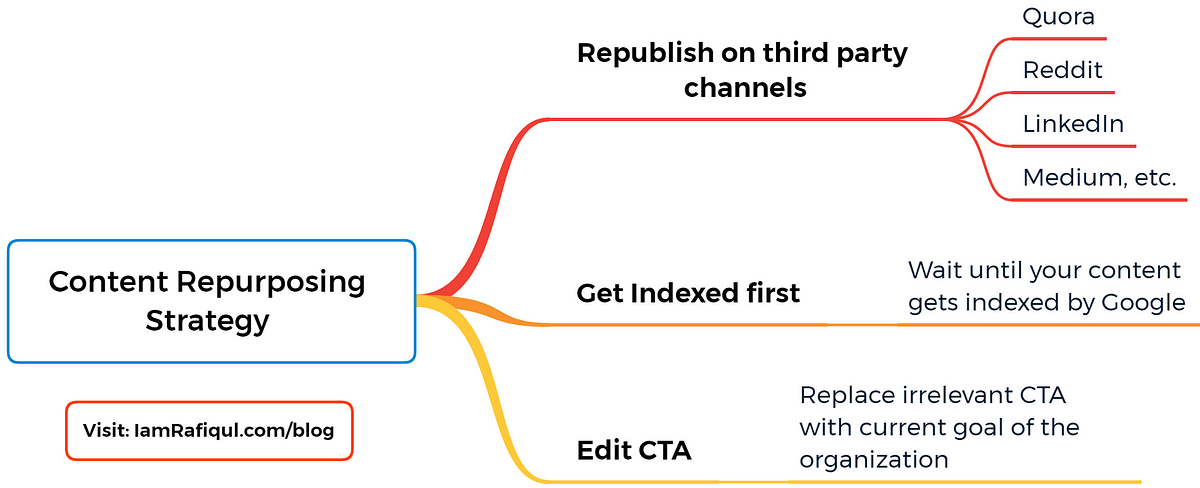
#1 Strategy. Republish on third party channels
Add relevant content, visuals, and more. Don’t just limit your content reach to only your blog.
There are many sites that you can republish your content without having any plagiarism issues.
Sites like LinkedIn, Quora, credit, Medium, and others are great for republishing your content.
Once you update, make sure that from republished content on the third-party channel, you’re linking back to the relevant content on your site.
You can also add banners to drive traffic from third party channels to your site.
# Strategy 2. First, get indexed before redistributing
Don’t just redistribute your content immediately after republishing the content on your site. You must make sure that the credit to the original content must be given to your site, not any third-party channel.
Nowadays, you can easily index your blog post by submitting the URL in Google search console. It hardly takes a few minutes.
So, wait until it gets indexed by Google. Scheduling the re-distribution for a couple of days is always safe.
# Strategy 3. Edit CTA
Add or edit CTA. It’s obvious that many times, you have written content for your special offer or product launch. In that case, you might have added CTA for that particular product or any offer that doesn’t exist now.
That is why you need to recheck the CTA for every blog post.
Whether you’re going to republish the content or not, correcting the CTA will help you to stay relevant.
Another way you can use this strategy is by changing the CTA of the blog posts that are performing well.
What you can do is replacing the old CTA from popular posts with CTA targeted to your product or service.
[A small Tip: Don’t be aggressive in selling your product or service through a blog post if targeted to the awareness stage. Because at the awareness stage, your audience is yet to know you, trust you. You might get some sales but bringing them into the buyers’ runner will give you better results in the long term]
That’s all that I have right now for you.
BUT… Don’t forget to read the last few words on this topic below.
Final Words

Content repurposing is great, and once you start applying these tactics, I am sure you’ll save lots of time.
Once I have enough content in my hand, what I do is schedule them accordingly. And this makes me super exciting.
While I am on deep sleep, My channels are kept publishing content from time to time.
I love automation especially in content marketing (If you want a detailed guide on how to automate your tasks, comment below)
Let me know what do you feel about this article.
You can also join my blog to get some cool and useful tips on Content strategy and content marketing plans.
Now, I am also going to repurpose this article into several social media posts.
Have a nice day!
(If you share this article, it will make my day)

Sk Rafiqul Islam is a content marketing practitioner with 3+ years of practical experience. He spends most of his time helping businesses to build a loyal audience with content marketing. He is also running a tech career blog called 10Pie and content marketing VIP, a bi-weekly marketing newsletter. In his free time, he loves reading books and playing football.
